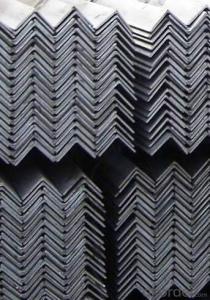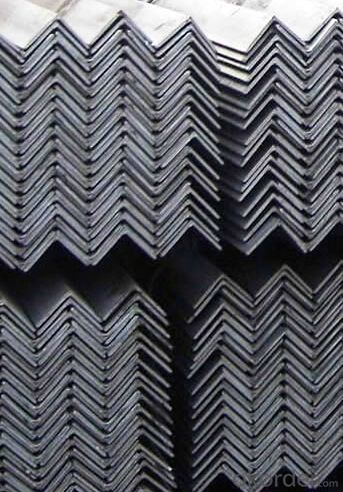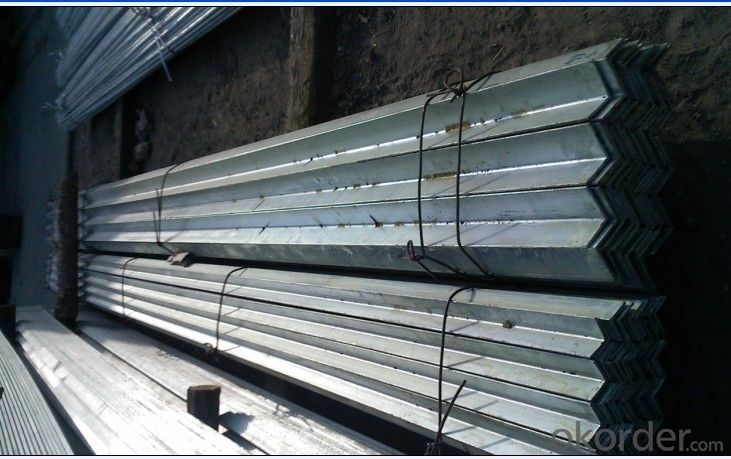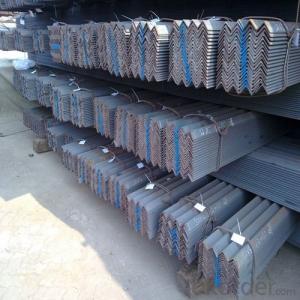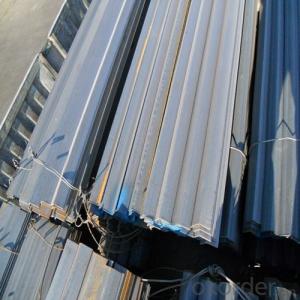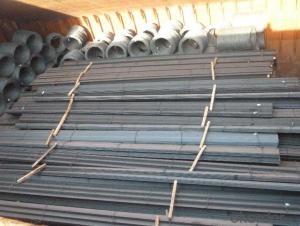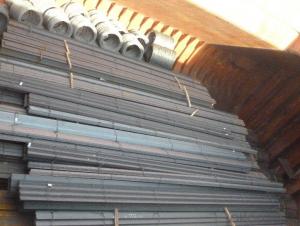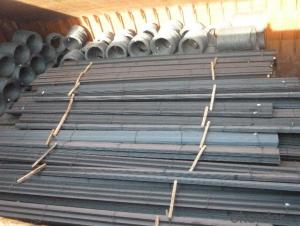Low Carbon Hot Rolled Steel Equal Angle Bars
- Loading Port:
- Tianjin
- Payment Terms:
- TT or LC
- Min Order Qty:
- 100 m.t.
- Supply Capability:
- 20000 m.t./month
OKorder Service Pledge
OKorder Financial Service
You Might Also Like
OKorder is offering Low Carbon Hot Rolled Steel Equal Angle Bars at great prices with worldwide shipping. Our supplier is a world-class manufacturer of steel, with our products utilized the world over. OKorder annually supplies products to African, South American and Asian markets. We provide quotations within 24 hours of receiving an inquiry and guarantee competitive prices.
Product Applications:
Low Carbon Hot Rolled Steel Equal Angle Barsare ideal for structural applications and are widely used in the construction of buildings and bridges, and the manufacturing, petrochemical, and transportation industries
Product Advantages:
OKorder's Low Carbon Hot Rolled Steel Equal Angle Bars are durable, strong, and wide variety of sizes.
Main Product Features:
· Premium quality
· Prompt delivery & seaworthy packing (30 days after receiving deposit)
· Can be recycled and reused
· Mill test certification
· Professional Service
· Competitive pricing
Product Specifications:
Manufacture: Hot rolled
Grade: Q195 – 235
Certificates: ISO, SGS, BV, CIQ
Length: 6m – 12m, as per customer request
Packaging: Export packing, nude packing, bundled
| EQUAL ANGLE STEEL | |||||
| size(mm) | a(mm) | a1(mm) | thickness(mm) | kg/m | length |
| 50*50*4 | 50 | 50 | 4 | 3.059 | 6m,9m,12m |
| 50*50*5 | 50 | 50 | 5 | 3.77 | 6m,9m,12m |
| 50*50*6 | 50 | 50 | 6 | 4.465 | 6m,9m,12m |
| 63*63*5 | 63 | 63 | 5 | 4.822 | 6m,9m,12m |
| 63*63*6 | 63 | 63 | 6 | 5.721 | 6m,9m,12m |
| 65*65*5 | 65 | 65 | 5 | 5 | 6m,9m,12m |
| 65*65*6 | 65 | 65 | 6 | 5.91 | 6m,9m,12m |
| 65*65*8 | 65 | 65 | 8 | 7.66 | 6m,9m,12m |
| 75*75*5 | 75 | 75 | 5 | 5.818 | 6m,9m,12m |
| 75*75*6 | 75 | 75 | 6 | 6.905 | 6m,9m,12m |
| 75*75*8 | 75 | 75 | 8 | 9.03 | 6m,9m,12m |
| 75*75*9 | 75 | 75 | 9 | 9.96 | 6m,9m,12m |
| 75*75*10 | 75 | 75 | 10 | 11.089 | 6m,9m,12m |
| 80*80*6 | 80 | 80 | 6 | 7.375 | 6m,9m,12m |
| 80*80*7 | 80 | 80 | 7 | 8.525 | 6m,9m,12m |
| 80*80*8 | 80 | 80 | 8 | 9.658 | 6m,9m,12m |
| 80*80*10 | 80 | 80 | 10 | 11.874 | 6m,9m,12m |
| 90*90*6 | 90 | 90 | 6 | 8.35 | 6m,9m,12m |
| 90*90*7 | 90 | 90 | 7 | 9.656 | 6m,9m,12m |
| 90*90*8 | 90 | 90 | 8 | 10.946 | 6m,9m,12m |
| 90*90*10 | 90 | 90 | 10 | 13.476 | 6m,9m,12m |
| 100*100*6 | 100 | 100 | 6 | 9.366 | 6m,9m,12m |
| 100*100*7 | 100 | 100 | 7 | 10.83 | 6m,9m,12m |
| 100*100*8 | 100 | 100 | 8 | 12.276 | 6m,9m,12m |
| 100*100*9 | 100 | 100 | 9 | 13.49 | 6m,9m,12m |
| 100*100*10 | 100 | 100 | 10 | 15.12 | 6m,9m,12m |
| 100*100*12 | 100 | 100 | 12 | 17.898 | 6m,9m,12m |
| 120*120*8 | 120 | 120 | 8 | 14.88 | 6m,9m,12m |
| 120*120*10 | 120 | 120 | 10 | 18.37 | 6m,9m,12m |
| 120*120*12 | 120 | 120 | 12 | 21.66 | 6m,9m,12m |
| 125*125*8 | 125 | 125 | 8 | 15.504 | 6m,9m,12m |
| 125*125*10 | 125 | 125 | 10 | 19.133 | 6m,9m,12m |
| 125*125*12 | 125 | 125 | 12 | 22.696 | 6m,9m,12m |
| 130*130*10 | 130 | 130 | 10 | 19.8 | 6m,9m,12m |
| 130*130*12 | 130 | 130 | 12 | 23.6 | 6m,9m,12m |
| 130*130*13 | 130 | 130 | 13 | 25.4 | 6m,9m,12m |
| 130*130*14 | 130 | 130 | 14 | 27.2 | 6m,9m,12m |
| 150*150*10 | 150 | 150 | 10 | 23 | 6m,9m,12m |
| 150*150*12 | 150 | 150 | 12 | 27.3 | 6m,9m,12m |
| 150*150*14 | 150 | 150 | 14 | 31.6 | 6m,9m,12m |
| 150*150*15 | 150 | 150 | 15 | 33.8 | 6m,9m,12m |
| 140*140*10 | 140 | 140 | 10 | 21.49 | 6m,9m,12m |
| 140*140*12 | 140 | 140 | 12 | 25.52 | 6m,9m,12m |
| 140*140*14 | 140 | 140 | 14 | 29.49 | 6m,9m,12m |
| 160*160*10 | 160 | 160 | 10 | 24.73 | 6m,9m,12m |
| 160*160*12 | 160 | 160 | 12 | 29.39 | 6m,9m,12m |
| 160*160*14 | 160 | 160 | 14 | 33.99 | 6m,9m,12m |
| 180*180*12 | 180 | 180 | 12 | 33.16 | 6m,9m,12m |
| 180*180*14 | 180 | 180 | 14 | 39.39 | 6m,9m,12m |
| 180*180*16 | 180 | 180 | 16 | 43.45 | 6m,9m,12m |
| 180*180*18 | 180 | 180 | 18 | 48.63 | 6m,9m,12m |
| 200*200*14 | 200 | 200 | 14 | 42.89 | 6m,9m,12m |
| 200*200*16 | 200 | 200 | 16 | 48.68 | 6m,9m,12m |
| 200*200*18 | 200 | 200 | 18 | 54.4 | 6m,9m,12m |
| 200*200*20 | 200 | 200 | 20 | 60.06 | 6m,9m,12m |
| 200*200*24 | 200 | 200 | 24 | 71.17 | 6m,9m,12m |
FAQ:
Q1: How do we guarantee the quality of our products?
A1: We have established an advanced quality management system which conducts strict quality tests at every step, from raw materials to the final product. At the same time, we provide extensive follow-up service assurances as required.
Q2: How soon can we receive the product after purchase?
A2: Within three days of placing an order, we will arrange production. The normal sizes with the normal grade can be produced within one month. The specific shipping date is dependent upon international and government factors, the delivery to international main port about 45-60days.
Q3: How many tons of steel products could be loaded in containers?
A3: Usually the steel products are delivered by bulk vessel because of the large quantity and the freight. However, there are no bulk vessel enter some seaports so that we have to deliver the cargo by containers. The 6m steel product can be loaded in 20FT container, but the quantity is changed according to the size, usually from 18tons to 25tons.
Images:
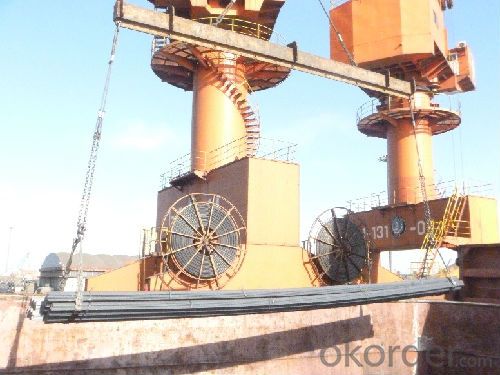
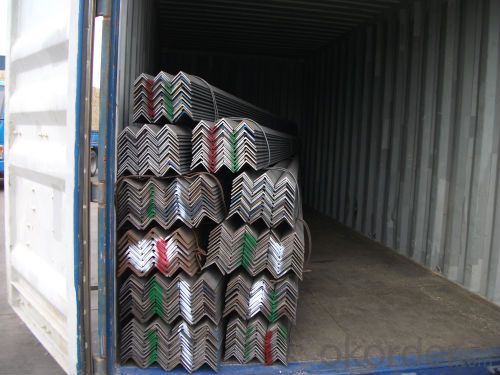
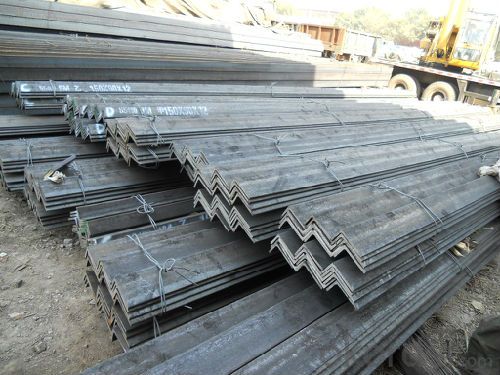
- Q: What is the maximum load capacity of a steel angle?
- The maximum load capacity of a steel angle depends on various factors such as the dimensions, thickness, and quality of the steel angle. It is essential to consult engineering specifications or contact a structural engineer to determine the specific maximum load capacity for a particular steel angle.
- Q: What is the standard tolerance for steel angles?
- The standard tolerance for steel angles typically ranges from +/- 1/8 inch to +/- 1/4 inch, depending on the specific dimensions and requirements of the angle.
- Q: How do you prevent steel angles from sagging?
- To prevent steel angles from sagging, there are several measures that can be taken: 1. Proper design: Ensure that the steel angles are designed and sized correctly for the load they will bear. This involves considering the span length, the applied load, and the material strength. Consulting with a structural engineer can help determine the appropriate size and thickness of the steel angles. 2. Adequate support: Provide sufficient support for the steel angles at regular intervals along their length. This can be achieved by using intermediate supports such as columns, beams, or braces. The spacing of these supports should be determined based on the load and the properties of the steel angles. 3. Reinforcement: Depending on the load requirements, additional reinforcements can be added to the steel angles. This can include stiffeners, gussets, or flanges to increase their load-carrying capacity and resistance to sagging. 4. Quality fabrication: Ensure that the steel angles are fabricated to meet industry standards and specifications. This includes proper welding techniques, accurate cutting, and appropriate surface preparation to avoid any weak points or defects that may contribute to sagging. 5. Regular inspection and maintenance: Regularly inspect the steel angles to identify any signs of sagging or structural issues. This can involve visual inspections, measurements, and non-destructive testing methods. Promptly address any identified problems to prevent further deformation and ensure the long-term integrity of the steel angles. By following these preventive measures, steel angles can be effectively protected against sagging and maintain their structural stability over time.
- Q: Can steel angles be galvanized or coated for additional protection?
- Indeed, steel angles can be galvanized or coated to enhance their protection. Galvanization is a widely used technique for safeguarding steel against corrosion. It entails applying a layer of zinc onto the steel, which acts as a barrier against moisture and other corrosive elements. This process can be accomplished through hot-dip galvanization, where the steel angle is immersed in a bath of molten zinc, or through electroplating, which involves applying a thin layer of zinc to the steel surface using an electric current. Furthermore, coating steel angles with alternative protective materials is a viable option. There are several coating choices available, including epoxy, powder coatings, and paint. These coatings establish a protective layer on the steel's surface, shielding it from environmental factors that may cause corrosion or damage. By applying galvanization or coatings to steel angles, additional protection is provided, thereby extending the material's lifespan and ensuring its durability in various applications and environments.
- Q: What are the different connection methods for steel angles?
- Some of the different connection methods for steel angles include welding, bolting, and using mechanical fasteners such as screws or rivets. These methods are used to join steel angles together or to connect them to other structural elements. The choice of connection method depends on factors such as the load requirements, the design specifications, and the ease of installation.
- Q: How do you design connections for steel angles to steel beams?
- Designing connections for steel angles to steel beams involves several steps and considerations. Here is a general outline of the process: 1. Determine the loads: The first step is to determine the loads that will act on the connection. This includes vertical loads, horizontal loads, and any applied moments. The loads will be used to determine the strength requirements for the connection. 2. Select the appropriate steel angles and beams: Based on the loads and the desired design criteria, select the appropriate steel angles and beams that will be used in the connection. Consider factors such as the material grade, size, and shape of the angles and beams. 3. Analyze the connection: Analyze the connection to determine the required connection strength. This involves calculating the shear, moment, and axial forces that will act on the connection. Use appropriate structural analysis methods and consider both the service loads and the ultimate strength requirements. 4. Determine the connection type: Based on the analysis, select the appropriate connection type. Common connection types for steel angles to steel beams include bolted connections, welded connections, and a combination of both. Consider factors such as the available space, ease of construction, and the structural requirements. 5. Design the connection: Design the connection to meet the required strength and performance criteria. This involves determining the number, size, and layout of bolts or welds, as well as any additional reinforcement or stiffeners that may be required. Consider factors such as the connection's resistance to shear, moment, and axial forces, as well as any specific design codes or standards that need to be followed. 6. Detailing and fabrication: Provide detailed drawings and specifications for the connection, including the dimensions, tolerances, and material specifications. Coordinate with fabricators and contractors to ensure that the connection can be accurately fabricated and installed. 7. Quality control and inspection: During fabrication and construction, perform quality control checks and inspections to ensure that the connection is being fabricated and installed correctly. This may include visual inspections, non-destructive testing, and load testing if required. It is essential to consult with a structural engineer or a professional experienced in steel connection design to ensure that the connection is designed safely and in compliance with applicable building codes and standards.
- Q: Can steel angles be used for HVAC ductwork?
- No, steel angles are not typically used for HVAC ductwork. Ductwork is commonly made from galvanized steel sheets or flexible materials such as aluminum or fiberglass. Steel angles are more commonly used for structural support or framing purposes.
- Q: What are the different types of steel angles used in transmission towers?
- There are primarily three types of steel angles that are commonly used in transmission towers: equal angles, unequal angles, and back-to-back angles. 1. Equal Angles: These steel angles have equal sides and are commonly denoted as L-shaped sections. They are often used as cross-arms in transmission towers, providing stability and support to the structure. Equal angles are suitable for carrying horizontal loads and are frequently used in the middle and upper sections of the tower. 2. Unequal Angles: As the name suggests, unequal angles have unequal sides. These angles are used in transmission towers to provide extra strength and stability in areas where the load distribution is not uniform. The longer side of the unequal angle is usually placed on the side where more strength is required. Unequal angles are commonly found in the lower sections of transmission towers. 3. Back-to-back Angles: Back-to-back angles are two equal angles joined together to form a single section. These angles are used in transmission towers to provide additional strength and rigidity to the structure. Back-to-back angles are often used in areas where the load distribution is not uniform, or where the tower needs to support heavier loads. They are commonly found in the base sections of transmission towers. The choice of steel angles used in transmission towers depends on various factors such as the tower's height, load requirements, and the specific design considerations. Engineers carefully analyze these factors to determine the most suitable type of steel angles for each section of the tower, ensuring the overall stability and strength of the transmission tower structure.
- Q: What is the minimum bend radius for a steel angle?
- The minimum bend radius for a steel angle depends on various factors such as the thickness of the angle, the type of steel, and the specific application. However, generally speaking, the minimum bend radius for a steel angle is typically equal to or slightly larger than the thickness of the angle itself.
- Q: What is the weight of a steel angle?
- The weight of a steel angle depends on its dimensions and density. To calculate the weight, one needs to know the length, width, and thickness of the steel angle. By multiplying the volume of the angle (length x width x thickness) by the density of steel, one can determine its weight. The density of steel is typically around 7.85 grams per cubic centimeter. Therefore, the weight of a steel angle can be calculated using the formula: weight = volume x density.
Send your message to us
Low Carbon Hot Rolled Steel Equal Angle Bars
- Loading Port:
- Tianjin
- Payment Terms:
- TT or LC
- Min Order Qty:
- 100 m.t.
- Supply Capability:
- 20000 m.t./month
OKorder Service Pledge
OKorder Financial Service
Similar products
Hot products
Hot Searches
Related keywords
